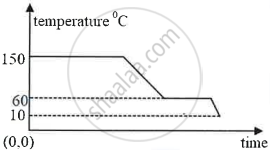Advertisements
Advertisements
प्रश्न
Water expands on reducing its temperature below ______°C.
विकल्प
0
4
8
12
उत्तर
Water expands on reducing its temperature below 4°C.
Explanation:
Anomalous expansion of water.
APPEARS IN
संबंधित प्रश्न
What is the energy absorbed during the phase change called?
Write the approximate value of specific latent heat of ice.
The S.I. unit of specific latent heat is ______.
Calculate the total amount of heat energy required to convert 100 g of ice at −10℃ completely into water at 100℃. Specific heat capacity of ice = 2.1 J g-1 K-1, specific heat capacity of water = 4.2 J g-1K-1, specific latent heat of ice = 336 J g-1.
What is meant by latent heat? How will the state of matter transform if latent heat is given off?
When a liquid is getting converted into solid, the latent heat is ………………………………
What is the name given to the energy absorbed during a phase change?
Explain why water is used in hot water bottles for fomentation and also as a universal coolant.
Define the term ‘specific latent heat of fusion’ of a substance.
Explain, why no tracks are left on the ice during ice skating?
Why does evaporation causes cooling and why is water used in hot water bottles?
Steam at 100°C is passed over 1000 g of ice at 0°C. After some time, 600 g of ice at 0°C is left and 450 g of water at 0°C is formed. Calculate the specific latent heat of vaporization of steam (Given: specific heat capacity of water = 4200 J/kg°C, specific latent heat of fusion of ice = 336,000 J/kg.)
If there is no Heat loss to the surroundings, the heat released by the condensation of m1 g of steam at 100°C into water at 100°C can be used to convert m2 g of ice at 0°C into water at 0°C.
(i) Find:
(a) The heat lost by steam in terms of m1
(b) The heat gained by ice in terms of m2
(ii) Form a heat equation find the ratio of m2 : m1
Specific latent heat of vaporization of steam = 2268 kJ/kg
Specific latent heat of fusion of ice = 336 kJ/kg
Specific heat capacity of water = 4200 J/kg°C
The latent heat of vaporisation is a term referred for the conversion of gas into liquid.
For the same mass of ice and ice-cold water, why does ice produce more cooling than ice-cold water?
2875 J of heat is required to melt 115 g of lead at its melting point. Calculate the specific latent heat capacity of fusion of lead.
The diagram below shows a cooling curve for a substance:

- State the temperatures at which the substance condenses.
- The temperature range in which the substance is in liquid state.
- Why do we prefer ice to ice-cold water for cooling a drink?
